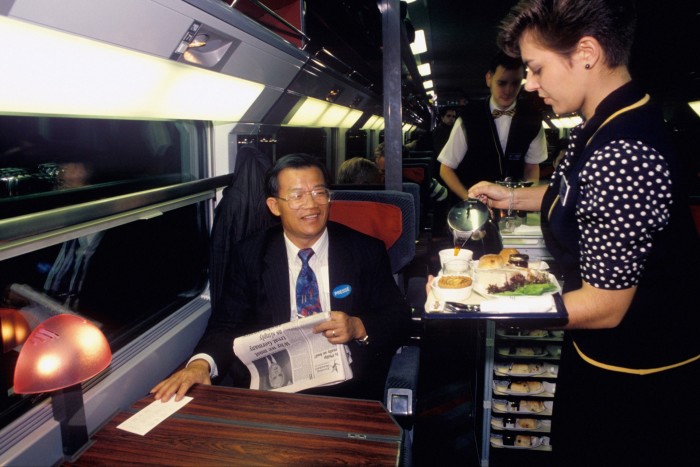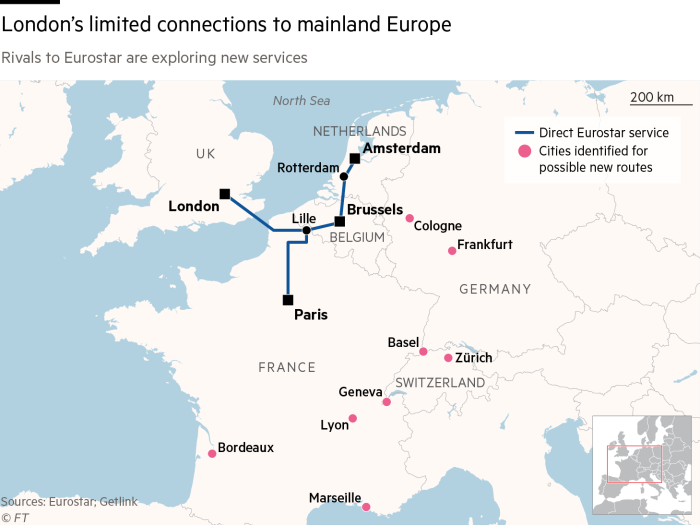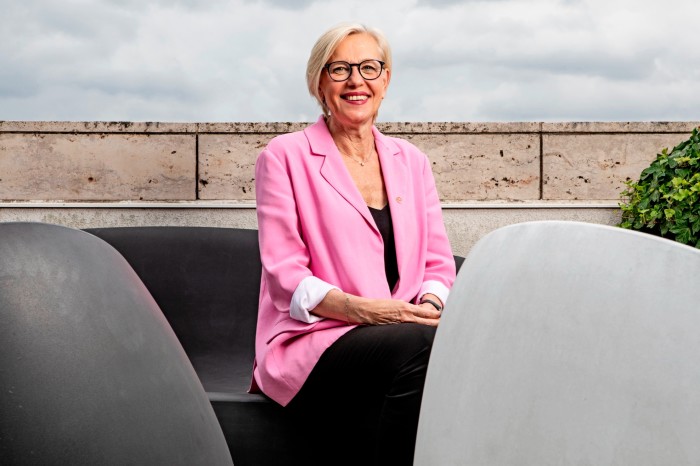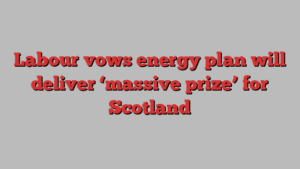
Eurostar has enjoyed a monopoly on passenger trains linking the UK to continental Europe since its first service left London Waterloo in 1994.
But today the operator is facing the most serious competitive threat in its 30-year history, with up to five companies looking at rival operations to run trains through the Channel Tunnel.
Sir Richard Branson’s Virgin Group; Evolyn, a Spanish-led consortium backed by the largest shareholder in Mobico, formerly known as National Express; and Dutch start-up Heuro have all in recent months said they are exploring opening new services. Industry executives say there are at least two other contenders.
“We have got more interest and more live conversations going on than we have ever had,” said Wendy Spinks, commercial director of HS1, the company that operates the high speed line linking London with the Channel Tunnel on the Kent coastline.
Access to some of the most lucrative rail lines in Europe is at stake, with new subsidies and simplified regulations freeing up the path. Eurostar’s cross-channel business made £122mn in net profit after tax from revenues of £1.3bn last year.
But the challengers’ route to success is fraught with the same financial and technical difficulties that have constrained Eurostar’s growth, and prevented any company from challenging it.

Among myriad hurdles, new entrants must buy trains that are compatible with the Channel Tunnel’s safety rules, and negotiate often expensive track access with infrastructure owners in multiple countries. Eurostar runs trains in five countries on four different traction systems and eight signalling systems.
There have been several false dawns in the past, most notably from German rail giant Deutsche Bahn, which abandoned plans to run trains between London and Germany in 2018 amid frustration over the difficulty of obtaining the necessary clearances.
HS1 and Getlink, the operator of the Channel Tunnel, want to encourage more trains on to their tracks, and are currently running at just half their potential capacity. But their access charges are also considered one of the biggest obstacles. HS1, for example, charges operators £119.95 per train per minute to run on its line.
Direct comparisons are difficult because of different charging calculations, but one railway executive said that was around seven times more than on the UK’s intercity lines. Both HS1 and Getlink expect their prices to drop if more trains run on their tracks.
Perhaps an even greater challenge is finding space in congested stations including London St Pancras, at a time when the border between the UK and EU is becoming more complex.
Eurostar ran some of its peak trains a third empty last year to prevent bottlenecks amid queues caused by post-Brexit passport checks. Complex new EU entry requirements including biometric tests loom from the autumn, potentially adding to delays, although Eurostar insists it can cope.
“St Pancras wasn’t designed for a hard border between Britain and Europe, it was designed for Britain in Europe with a light border. This is a major issue,” said Mark Smith, a former rail regulator who runs the international rail travel website The Man in Seat 61.
“You would have to be a glutton for punishment to want to run to and from London, rather than say running between Amsterdam or Paris to Brussels,” he said.

When the UK government was selling the vision of the tunnel to MPs in the 1980s, it conjured a vision of a far more extensive network of cross-Channel rail services than ever materialised, including trains from Manchester and Leeds and sleeper services from Swansea.
In the end, as costs rose and rivalry grew from low-cost air travel, Eurostar launched with just two core routes linking London to Paris and Brussels. It took 15 years to become consistently profitable, and 24 years for direct services between London and Amsterdam to launch.
But industry executives believe several factors have combined to make starting new services more viable.
The EU has liberalised its own cross-border rail services, encouraging competition on to busy lines to drive passenger numbers higher and eat into the low-cost air market amid pressure to cut carbon emissions from transport.
The high speed line linking London to the continent is now one of the very few in Europe without competition.
Increased environmental awareness has also left people willing to tackle longer train journeys, with routes of six hours or more now seen as competitive against flying. Getlink believes there is demand for 4mn rail passenger journeys a year from Germany and Switzerland to London.
The technical barriers to entry, while still formidable, have also lowered recently, according to Yann Leriche, Getlink’s chief executive. His company has earmarked at least €50mn to spend over the next five years on direct subsidies to support any new operator launching a service.
It has also worked to streamline the regulatory process to certify new operators to run trains through the tunnel.
Meanwhile new high speed trains developed by French manufacturer Alstom are designed to comply with the tunnel’s safety rules, meaning any new operator would not have to pay for a new train to be designed from scratch.
Taken together, Leriche believes it would take a new entrant five years to launch a rival to Eurostar instead of the previous 10. “There are still hurdles, but they used to be quite high and now they are very limited,” he said.
HS1, which owns St Pancras, is also preparing to commission studies into how to increase the capacity of the crowded station, where passengers go through airport style security and passport checks. The station runs at close to capacity at peak times, but Spinks said there is scope to increase throughput considerably by redesigning parts of it.
Roemer van den Biggelaar, co-founder of Heuro, estimates it would cost between €100mn and €150mn to set up its planned service, which includes 15 trains a day between London and Amsterdam, excluding the costs of the rolling stock.
He said the start-up, which is preparing a second funding round, has held talks with four train manufacturers, Talgo, Hitachi, Alstom and Siemens over a possible order. Evolyn, meanwhile, in October announced a preliminary agreement with Alstom to explore options for a train compatible with the Channel Tunnel, though it has yet to place a firm order. Virgin Group said it is studying the practicalities of launching its own services, but has yet to give details on any potential train order.
Perhaps the biggest problem for new operators will be Eurostar itself. Gwendoline Cazenave has made expansion her priority since she took over as chief executive in 2022. In May she announced plans to buy 50 more trains and explore new routes from London.

As an established operator, Eurostar could hoover up new capacity on its routes and shut any potential rival out of the market.
“It’s a race. The sooner the better. The market is pushing so hard, that we really need to see which manufacturer is going to be able to be ready as quick as possible,” Cazenave said of the new train order.
But for many, a new operator is important to drive competition and lower fares.
“Competition keeps everyone on their toes, and it is known to keep prices down . . . I think it will happen. But it wont happen quickly. The lead time is long and I think there’ll be lots of hiccups on the way,” Smith said.
Van den Biggelaar hopes that there are similarities between the growth of the cross-border rail market and the successful liberalisation of European aviation in the 1980s and 1990s.
“Forty years later . . . you see these train companies are the new easyJet, Ryanair or [US carrier] Southwest Airlines, going up against the big incumbents. If you look at that comparison I really think it is doable.”

